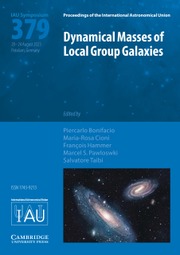No CrossRef data available.
Article contents
Probing the Structure of SDSS J1004+4112 through Microlensing Analysis of Spectroscopic Data
Published online by Cambridge University Press: 04 March 2024
Abstract
We aim to uncover the structure of the continuum and broad emission line (BEL) emitting regions in the gravitationally lensed quasar SDSS J1004+4112 through unique microlensing signatures. Analyzing 20 spectroscopic observations from 2003 to 2018, we study the striking deformations of various BEL profiles and determine the sizes of their respective emitting regions. We use the emission line cores as a baseline for no microlensing and then apply Bayesian methods to derive the sizes of the Lyα, Si IV, C IV, C III], and Mg II emitting regions, as well as of the underlying continuum-emitting sources. We find that the sizes of the emitting regions for the BELs are a few light-days across, notably smaller than in typical lensed quasars. The asymmetric distortions observed in the BELs suggest that the broad-line region lacks spherical symmetry and is likely confined to a plane. The inferred continuum emitting region sizes are larger than predictions based on standard thin-disk theory by a factor of ∼ 4. We find that the size-wavelength relation is in agreement with that of a geometrically thin and optically thick accretion disk.
Keywords
- Type
- Contributed Paper
- Information
- Proceedings of the International Astronomical Union , Volume 18 , Symposium S381: Strong Gravitational Lensing in the Era of Big Data , December 2022 , pp. 162 - 167
- Creative Commons
- This is an Open Access article, distributed under the terms of the Creative Commons Attribution licence (http://creativecommons.org/licenses/by/4.0/), which permits unrestricted re-use, distribution and reproduction, provided the original article is properly cited.
- Copyright
- © The Author(s), 2024. Published by Cambridge University Press on behalf of International Astronomical Union



